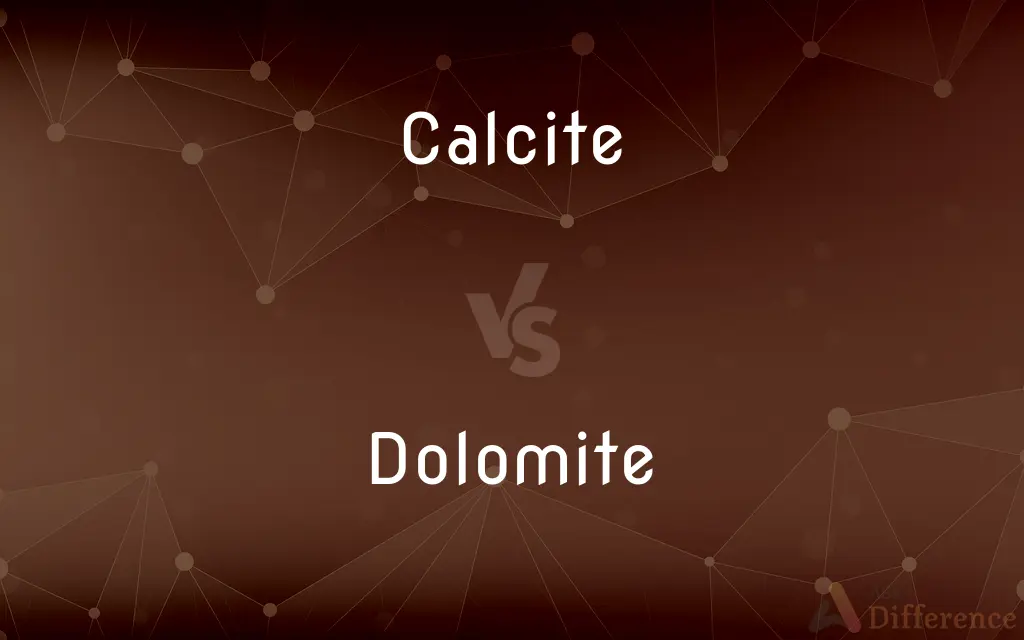Calcite vs. Dolomite — What's the Difference?
By Tayyaba Rehman & Maham Liaqat — Updated on March 29, 2024
Calcite is a carbonate mineral with the chemical formula CaCO3, forming the majority of limestone, while dolomite is a mineral comprising calcium magnesium carbonate (CaMg(CO3)2), essential in dolostone and marble.

Difference Between Calcite and Dolomite
Table of Contents
ADVERTISEMENT
Key Differences
Calcite is one of the most abundant and widely distributed minerals, known for its presence in sedimentary, metamorphic, and igneous rocks, as well as its role in the formation of limestone and marble. Dolomite, on the other hand, is less abundant but significant for its use in construction materials and as a host rock for lead, zinc, and copper ores.
Calcite reacts vigorously with dilute hydrochloric acid to produce carbon dioxide bubbles, a key property in geological fieldwork for identifying carbonate rocks. Whereas dolomite reacts slowly or only when powdered due to its different composition, offering a distinctive way to distinguish between the two minerals in the field.
In terms of industrial uses, calcite is a crucial component in the manufacture of cement and lime, also used in the production of plastics, paints, and paper. Dolomite serves as a source of magnesium oxide for the steel industry, in addition to its use in agriculture to neutralize acidic soils.
Calcite's crystal structure allows for a wide variety of crystal shapes, including prismatic, scalenohedral, and rhombohedral, contributing to its popularity among mineral collectors. Dolomite typically crystallizes in a trigonal-rhombohedral system, leading to its characteristic curved crystal faces, which are less varied than those of calcite.
Environmental conditions play a significant role in the formation of calcite, which can precipitate directly from water in cave systems to form stalactites and stalagmites. In contrast, dolomite formation is less understood, often requiring specific conditions for its primary formation or secondary from the alteration of limestone through magnesium-rich fluids.
ADVERTISEMENT
Comparison Chart
Chemical Formula
CaCO3
CaMg(CO3)2
Acid Reaction
Reacts vigorously with HCl
Reacts slowly or when powdered
Industrial Uses
Cement, lime, plastics, paints
Steel industry, agriculture
Crystal Shapes
Prismatic, scalenohedral
Trigonal-rhombohedral, curved faces
Formation
Direct precipitation from water
Secondary from limestone or primary under specific conditions
Compare with Definitions
Calcite
Calcite contributes to the alkalinity of seawater.
The dissolution of calcite in seawater helps regulate its pH level.
Dolomite
Dolomite's slow reaction to acid helps geologists.
The acid test on powdered dolomite helps distinguish it from calcite in the field.
Calcite
It forms through both biological and non-biological processes.
Many marine organisms use calcite to construct their shells.
Dolomite
Dolomite forms extensive beds of sedimentary rock.
The Dolomite Alps in Italy are composed largely of dolomite rock.
Calcite
Calcite can be found in many colors.
Iceland spar is a clear variety of calcite known for its optical properties.
Dolomite
It's used to neutralize acidic soils in agriculture.
Ground dolomite lime is spread on fields to adjust soil pH.
Calcite
It's used in the production of cement.
Calcite is crushed and burned to create cement.
Dolomite
Dolomite can host valuable ore deposits.
Some dolomite layers contain significant deposits of lead and zinc.
Calcite
Calcite is a primary mineral in cave formations.
Stalactites and stalagmites in caves are often composed of calcite.
Dolomite
It alters to form magnesite and talc.
Dolomite can chemically alter to form magnesite (magnesium carbonate) under certain conditions.
Calcite
Calcite is a carbonate mineral and the most stable polymorph of calcium carbonate (CaCO3). The Mohs scale of mineral hardness, based on scratch hardness comparison, defines value 3 as "calcite".
Dolomite
A white or light-colored mineral, essentially CaMg(CO3)2, used in fertilizer, as a furnace refractory, and as a construction and ceramic material.
Calcite
A common crystalline form of natural calcium carbonate, CaCO3, that is the basic constituent of limestone, marble, and chalk. Also called calcspar.
Dolomite
A magnesia-rich sedimentary rock resembling limestone.
Calcite
(mineral) a very widely distributed crystalline form of calcium carbonate, CaCO3, found as limestone, chalk and marble
Dolomite
(mineral) An evaporite consisting of a mixed calcium and magnesium carbonate, with the chemical formula CaMg(CO3)2; it also exists as the rock dolostone.
Calcite
Calcium carbonate, or carbonate of lime. It is rhombohedral in its crystallization, and thus distinguished from aragonite. It includes common limestone, chalk, and marble. Called also calc-spar and calcareous spar.
Dolomite
A mineral consisting of the carbonate of lime and magnesia in varying proportions. It occurs in distinct crystals, and in extensive beds as a compact limestone, often crystalline granular, either white or clouded. It includes much of the common white marble. Also called bitter spar.
Calcite
A common mineral consisting of crystallized calcium carbonate; a major constituent of limestone
Dolomite
A kind of sedimentary rock resembling limestone but consisting almost entirely of the mineral dolomite
Dolomite
A light colored mineral consisting of calcium magnesium carbonate; a source of magnesium; used as a ceramic and as fertilizer
Common Curiosities
What is dolomite?
Dolomite is a mineral and rock composed of calcium magnesium carbonate (CaMg(CO3)2), used in various industries and as a rock-forming mineral.
Can calcite and dolomite form together in the same rock?
Yes, both minerals can coexist in rocks such as dolostone, which can contain calcite as a component.
How do calcite and dolomite react with acid?
Calcite reacts vigorously with dilute hydrochloric acid, while dolomite reacts slowly or only when powdered.
What is calcite?
Calcite is a carbonate mineral, primarily made of calcium carbonate (CaCO3), widely found in various rock types.
How are calcite and dolomite formed?
Calcite forms through both biological and non-biological processes, often precipitating from water, while dolomite can form from the alteration of limestone or under specific conditions.
How do geologists distinguish between calcite and dolomite in the field?
The reaction with dilute hydrochloric acid is a common method; calcite fizzes vigorously, while dolomite reacts more slowly or when powdered.
Why is dolomite less understood than calcite?
The conditions for dolomite's primary formation are more specific and less common, making its geological process less understood.
What are the industrial uses of calcite and dolomite?
Calcite is used in cement, lime, plastics, and paints, while dolomite is used in the steel industry and agriculture.
What are the crystal shapes of calcite and dolomite?
Calcite can form in a variety of shapes, including prismatic and scalenohedral, while dolomite often forms trigonal-rhombohedral crystals with curved faces.
What are the visual differences between calcite and dolomite?
Besides crystal shape, dolomite typically has a more subdued reaction to acid, which can help in visual identification.
Why is dolomite important in agriculture?
Dolomite is important for neutralizing acidic soils, thereby improving soil health and crop yields.
What role does calcite play in the environment?
Calcite contributes to the alkalinity of seawater and is a major component of marine organisms' shells.
How does dolomite affect the steel industry?
Dolomite is a source of magnesium oxide, necessary in the production and processing of steel.
Can calcite and dolomite be used in the construction industry?
Yes, both minerals are used in construction; calcite as a component of cement and dolomite for its strength and durability.
Are there any health concerns associated with calcite and dolomite?
In their natural mineral form, they pose little to no health risks, but dust from processing can be a respiratory irritant.
Share Your Discovery

Previous Comparison
Psychometrist vs. Psychometrician
Next Comparison
Ketch vs. YawlAuthor Spotlight
Written by
Tayyaba RehmanTayyaba Rehman is a distinguished writer, currently serving as a primary contributor to askdifference.com. As a researcher in semantics and etymology, Tayyaba's passion for the complexity of languages and their distinctions has found a perfect home on the platform. Tayyaba delves into the intricacies of language, distinguishing between commonly confused words and phrases, thereby providing clarity for readers worldwide.
Co-written by
Maham Liaqat













































